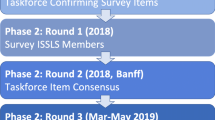Abstract.
Lumbar spinal stenosis (LSS) and diabetic polyneuropathy are common ailments of older age. Many people suffer from both at the same time. In such patients it may sometimes be difficult to separate signs and symptoms that could be attributed to either disease. This study evaluates the contributions and limits of various tests, especially the exercise treadmill test (ETT) and electrophysiological examination, in the diagnostics of patients with mild LSS. Twenty-nine patients with mild LSS documented by computed tomography (CT) participated in this study. Sixteen of the patients had neurogenic claudication (LSS NC+), and 13 patients did not (LSS NC–). Patients with LSS were compared with a group of 24 patients with diabetic polyneuropathy and 25 healthy volunteers. The distance covered, the time spent walking and the reasons for preliminary termination of the ETT were evaluated in all groups. Initial electrophysiological examination included electromyography (EMG) from the upper and lower extremities and motor evoked potentials (MEPs) to the lower extremities. LSS NC+ patients covered a significantly shorter distance and the time spent walking was significantly shorter than in LSS NC– patients and in the two control groups. The main reason for preliminary termination of the ETT was the development of NC in 67% of the LSS NC+ patients. In contrast, no LSS NC– patient and none from the control groups revealed NC, but 31% of LSS NC– patients were not able to finish the ETT for other reasons (e.g. dyspnoea). Electrophysiological parameters evaluated from the upper extremities distinguished diabetic patients from LSS patients. The latencies of the tibial F-wave, soleus H-reflex and spinal MEP response reliably distinguished healthy volunteers from diabetic patients and LSS patients, and particularly LSS patients from diabetic patients. The chronodispersion of the tibial F-wave distinguished LSS NC+ patients from the other groups. The results of the study show that electrophysiological examination contributes to the differential diagnostics between mild lumbar spinal stenosis and diabetic polyneuropathy. The contribution of electrophysiological methods in verification of NC in LSS patients is limited (chronodispersion of the tibial F-wave only). The ETT is useful in confirmation of NC and walking capacity verification, but restriction of walking capacity should be carefully analysed.
Similar content being viewed by others
Author information
Authors and Affiliations
Additional information
Electronic Publication
Rights and permissions
About this article
Cite this article
Adamova, .B., Vohanka, .S. & Dusek, .L. Differential diagnostics in patients with mild lumbar spinal stenosis: the contributions and limits of various tests. Eur Spine J 12, 190–196 (2003). https://doi.org/10.1007/s00586-002-0503-x
Received:
Revised:
Accepted:
Issue Date:
DOI: https://doi.org/10.1007/s00586-002-0503-x




